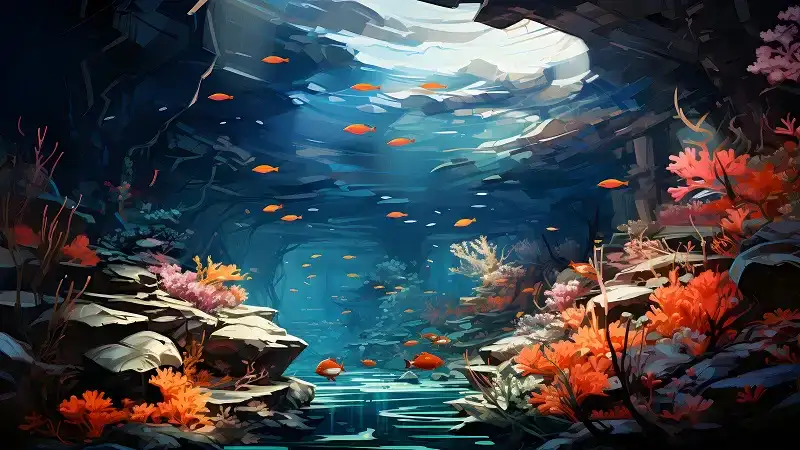The ocean, a vast and mysterious expanse that covers”underwater:3u1qizs_9ra= ocean” more than 70% of our planet, has fascinated humans for centuries. The underwater world, in particular, holds an unparalleled sense of wonder, inviting us to explore its depths, understand its ecosystems, and appreciate its beauty. From shimmering coral reefs to the darkest ocean trenches, the ocean harbors life in forms and numbers that are beyond our wildest imaginations. It is a world filled with vibrant marine species, hidden treasures, and unexplored terrain. Additionally, the ocean plays a crucial role in regulating Earth’s climate and supports livelihoods and biodiversity in ways that many people are just beginning to understand.
Exploring the underwater world is not just about adventure—it is about gaining a deeper connection with nature and acknowledging the critical importance of ocean conservation. As we dive deeper into this topic, we’ll uncover the fascinating life beneath the surface, the challenges facing marine ecosystems, and why the ocean remains one of the most captivating environments on Earth. Moreover, as we transition through different areas of ocean exploration, it will become clear how important it is to protect these vital ecosystems for future generations.
The Fascination with the Underwater World
From a young age, many of us feel a natural curiosity about the ocean. The thought of what lies beneath the waves—schools of fish, majestic whales, and colorful coral reefs—stirs our imagination. In fact, much of the allure of the ocean comes from its unexplored depths. Despite advances in marine technology, only about 20% of the world’s oceans have been mapped or explored by humans. This means there are still numerous mysteries waiting to be uncovered.
One of the most fascinating aspects of the”underwater:3u1qizs_9ra= ocean” underwater world is its diversity. Coral reefs, for example, are often called the “rainforests of the sea” because they are home to an astonishing array of species. Fish, sea turtles, and other marine animals live in a delicate balance on these reefs, depending on each other for survival. Moreover, the deeper parts of the ocean are equally captivating, filled with creatures that have adapted to survive in extreme conditions, such as bioluminescent species that light up the ocean floor.
Transitioning from the vibrant reefs to the open ocean, the variety of life is immense, ranging from the tiniest plankton to the largest mammals on Earth—blue whales. Each zone of the ocean offers a new perspective on marine life, demonstrating the complexity and resilience of the ecosystems found underwater.
Life Beneath the Waves
The life that exists underwater is as diverse as it is mesmerizing. Coral reefs are undoubtedly some of the most well-known underwater ecosystems, supporting thousands of marine species. Coral itself is a living organism, forming massive colonies that create underwater structures where fish, crustaceans, and other sea life take shelter. The vivid colors of coral reefs are home to tropical fish, such as clownfish, parrotfish, and angelfish, which swim through the vibrant anemones and sea plants.
Moving away from coral reefs, the open ocean is another fascinating environment. While it may appear vast and empty at first glance, the open ocean is teeming with life. Schools of fish, sharks, dolphins, and other species roam the waters in search of food and mates. Dolphins, known for their intelligence and social behaviors, often form close-knit pods, communicating through clicks and whistles. Furthermore, large marine mammals like whales migrate through the open ocean, sometimes covering thousands of miles in search of feeding grounds. These magnificent creatures remind us of the vastness and interconnectedness of life underwater.
Another extraordinary part of ocean exploration is”underwater:3u1qizs_9ra= ocean” discovering the deep-sea creatures that thrive in the abyssal plains and trenches. These areas are characterized by complete darkness, freezing temperatures, and immense pressure. Despite these harsh conditions, life flourishes. Deep-sea organisms like the anglerfish, giant squid, and yeti crab have developed unique adaptations to survive in these extreme environments. Many of these creatures are still being studied, adding to the intrigue and mystery of the underwater world.
The Importance of the Ocean to Our Planet
The ocean isn’t just a place of beauty and mystery; it is also”underwater:3u1qizs_9ra= ocean” an essential component of the Earth’s climate system. Oceans absorb vast amounts of heat from the sun, acting as a buffer against extreme temperatures. They are also a key component in the carbon cycle, absorbing and storing significant amounts of carbon dioxide, which helps to regulate the Earth’s atmosphere. Without the ocean’s regulatory role, life on land would look very different.
Moreover, ocean currents play a critical role in transporting heat around the globe. The Gulf Stream, for example, carries warm water from the Gulf of Mexico across the Atlantic to Europe, significantly influencing weather patterns. Additionally, the ocean generates half of the oxygen we breathe through the process of photosynthesis by marine plants like phytoplankton. These microscopic organisms are the foundation of the marine food chain and are vital for the health of the planet.
Transitioning from the ocean’s regulatory functions to its economic significance, we see that the ocean supports millions of people around the world through fisheries, tourism, and transportation. Fishing provides livelihoods for communities across the globe, while coastal tourism boosts economies by attracting millions of visitors to beaches, coral reefs, and marine parks each year. In addition, about 90% of global trade is carried by sea, demonstrating how integral the ocean is to commerce and industry.
Threats to the Ocean
Unfortunately, the ocean faces numerous challenges, many”underwater:3u1qizs_9ra= ocean” of which are the result of human activity. Pollution, overfishing, and climate change are some of the most pressing issues affecting marine ecosystems today. Plastic pollution, in particular, has become a significant threat to marine life, with an estimated 8 million tons of plastic entering the ocean each year. These plastics break down into microplastics, which are ingested by marine animals, causing harm to the entire food chain.
Furthermore, overfishing has led to the depletion of fish stocks worldwide, disrupting ecosystems and threatening the livelihoods of communities that rely on fishing. Unsustainable fishing practices, such as trawling, also damage coral reefs and seafloor habitats, further endangering marine species. On top of this, rising ocean temperatures, a direct consequence of climate change, have caused coral bleaching, where reefs lose their vibrant colors and become more vulnerable to disease and death.
Transitioning to solutions, it is clear that action must be taken”underwater:3u1qizs_9ra= ocean” to mitigate these threats and protect the ocean. Reducing plastic use, implementing sustainable fishing practices, and taking strong action on climate change are all critical steps that need to be prioritized.
The Future of Ocean Conservation
As we explore the wonders of the underwater world, it’s important to recognize the urgency of protecting the ocean for future generations. Ocean conservation efforts are gaining momentum, with marine protected areas (MPAs) being established around the globe to safeguard critical ecosystems. These areas limit human activity, allowing marine species to recover and thrive.
In addition, technological advancements in marine research are allowing scientists to study the ocean more closely than ever before. Autonomous underwater vehicles (AUVs), remote-operated vehicles (ROVs), and advanced sonar technology are helping researchers map uncharted areas of the ocean and observe marine life in its natural habitat. These innovations hold the key to unlocking many of the ocean’s remaining mysteries while supporting conservation efforts.
At the same time, individuals can play a role in ocean conservation by reducing their plastic usage, supporting sustainable seafood practices, and raising awareness about the importance of healthy oceans. Collectively, these efforts will ensure that the underwater world remains a vibrant and vital part of our planet’s ecosystem.
Conclusion: The Ocean’s Infinite Beauty and Importance
The underwater world is a breathtaking and vital part”underwater:3u1qizs_9ra= ocean” of our planet that is teeming with life and wonder. From the shallow coral reefs to the dark, unexplored depths, the ocean holds many secrets that continue to inspire awe and curiosity. It plays a crucial role in regulating Earth’s climate, supporting marine biodiversity, and providing livelihoods for millions. However, with growing threats from pollution, overfishing, and climate change, the future of the ocean is at risk. See More










